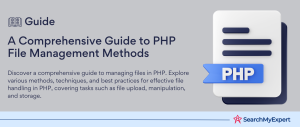HP and SEO: Best Practices – Unraveling the Synergy
PHP: The Powerhouse Behind Dynamic Websites
PHP, a cornerstone in the realm of server-side scripting, breathes life into dynamic websites. It’s the invisible force turning static HTML into interactive experiences. In the digital realm, PHP is akin to a puppeteer, pulling strings behind the scenes to craft seamless, user-driven web pages.
SEO: The Lifeline of Digital Visibility
SEO, or Search Engine Optimization, is the art of becoming the needle in the digital haystack. It’s about mastering the search engine’s language, and ensuring your website isn’t just a drop in the ocean. SEO is the compass that guides organic traffic to your website, navigating through the maze of online content.
PHP and SEO: A Match Made in Digital Heaven
Merging PHP with SEO is like combining a master chef with the finest ingredients. PHP’s versatility in creating dynamic, content-rich websites complements SEO’s goal of enhancing online visibility. This synergy isn’t just about coexistence; it’s about leveraging PHP’s capabilities to fuel SEO success.
The Unique Advantages of PHP in SEO
- Dynamic Content Generation: PHP’s ability to generate fresh, relevant content keeps websites lively and attractive to search engines.
- Customized User Experiences:
With PHP, personalization isn’t just a buzzword; it’s a reality. Tailored content means better user engagement, a key SEO metric. - Speed and Efficiency: PHP’s prowess in backend operations ensures websites are fast and responsive, a critical factor in SEO rankings.
- Seamless Integrations: PHP’s compatibility with various databases and APIs makes it a versatile tool in an SEO strategist’s arsenal.
PHP is not just a programming language. It’s a catalyst in the SEO equation, a tool that, when wielded with expertise, can significantly boost a website’s presence in the digital world.
Keyword Research and Targeting
The Cornerstone of SEO: Keyword Research
Keyword Research is the compass guiding your SEO journey. It’s not just about finding words; it’s about uncovering the language your audience speaks. Think of it as the DNA of your SEO strategy, essential for ensuring your content resonates with your target audience.
Tools and Techniques: Unearthing the Right Keywords
Harnessing Digital Tools:
- Google Keyword Planner: A classic, offering insights into search volumes and competition.
- SEMRush:
A comprehensive suite for keyword analysis and competitive intelligence. - Ahrefs: Excellent for uncovering long-tail keywords and content gaps.
Understanding Search Intent:
- Analyze keywords based on user intent – informational, navigational, transactional, or commercial.
Competitive Analysis:
- Scrutinize competitors’ keywords to identify opportunities and gaps in your strategy.
Strategic Keyword Integration in PHP-driven Websites
Content Is King:
- Infuse keywords naturally into high-quality, relevant content. Avoid keyword stuffing.
- Regularly update content to keep it fresh and engaging.
Metadata Matters:
- Title Tags:
Incorporate primary keywords in a concise, appealing manner. - Meta Descriptions: Craft compelling descriptions with a mix of primary and secondary keywords.
- Headers and Subheaders:
Use H1, H2, etc., to structure content and embed keywords.
URL Optimization:
- Include keywords in URLs to enhance relevance and visibility.
Alt Text for Images:
- Leverage alt text in images to include keywords, improving accessibility and SEO.
Responsive Design:
- Ensure your PHP site is mobile-friendly, as mobile optimization is crucial for SEO.
By integrating these practices, you can transform your PHP website into an SEO powerhouse, ensuring it speaks the language of both search engines and your audience.
On-Page Optimization with PHP
Crafting SEO-Friendly Elements with PHP
SEO-Friendly URLs:
- PHP enables the creation of clean, keyword-rich URLs, crucial for both user experience and SEO.
- Techniques:
Use URL rewriting and route parameters to create readable, concise URLs.
Optimizing Titles and Meta Descriptions:
- Dynamically generate titles and descriptions with PHP, ensuring they are compelling and keyword-optimized.
- Techniques: Utilize PHP’s string manipulation functions to craft unique, SEO-optimized titles and meta tags for each page.
Dynamic Content Generation: Balancing Keywords and Experience
Creating Relevant Content:
- Use PHP to dynamically serve content based on user preferences and search queries.
- Techniques: Implement conditional statements and database queries to personalize content.
Avoiding Keyword Stuffing:
- Ensure the natural incorporation of keywords, prioritizing readability and value.
Structuring Content for SEO
Effective Use of Header Tags:
- Utilize PHP to dynamically insert H1, H2, and other header tags, organizing content hierarchically.
- Techniques:
Apply PHP loops and conditions to structure content sections effectively.
Internal Linking Strategy:
- PHP can automate the creation of internal links, enhancing site navigation and distributing page authority.
- Techniques:
Use PHP to identify related content and generate relevant internal links.
By employing PHP’s flexibility and dynamic capabilities, you can significantly enhance your website’s on-page SEO, creating an environment that’s both search engine and user-friendly.
Technical SEO and PHP Development
Clean, Semantically-Structured HTML via PHP
The Backbone of Web Accessibility:
- PHP’s role in generating clean HTML is pivotal for both SEO and user accessibility.
- Techniques: Ensure semantic use of HTML tags and proper nesting.
Optimizing Page Load Speed: PHP’s Role
PHP Caching:
- Implement caching to reduce server load and speed up page delivery.
- Techniques: Use PHP caching tools like APCu and OpCache.
Code Optimization:
- Optimize PHP code for performance; efficient code equals faster load times.
- Techniques: Minimize database queries and use PHP profilers for performance tuning.
Robots.txt and Sitemap.xml: Guiding Search Engine Bots
Implementing robots.txt with PHP:
- Use PHP to dynamically create and update robots.txt, guiding search bots.
- Techniques:
Dynamically disallow or allow bot access to specific sections of your site.
Crafting sitemap.xml:
- Generate sitemap.xml files with PHP to ensure search engines can easily navigate and index your site.
- Techniques: Use PHP scripts to automate sitemap updates when content changes.
By harnessing PHP’s capabilities, you can significantly enhance the technical SEO aspects of your website, ensuring it’s not only search engine friendly but also offers a seamless user experience.
Schema Markup Integration
Unraveling Schema Markup: A SEO Power Tool
The Essence of Schema Markup:
- Schema markup, a form of microdata, adds context to website content, making it comprehensible to search engines.
- Benefits:
Enhances SERP presentation, improves search relevance, and drives higher click-through rates.
PHP in Action: Implementing Schema Markup
Utilizing PHP Libraries:
- Leverage PHP libraries like Schema.org and JSON-LD to integrate schema markup.
- Techniques: Embed structured data in HTML to provide detailed information about webpage content.
Custom Functions for Dynamic Markup:
- Create custom PHP functions to generate dynamic schema markup based on content type.
- Techniques:
Use arrays and objects in PHP to structure schema data efficiently.
The Impact: Rich Snippets and Enhanced Search Results
Transforming Search Results:
- Schema markup leads to rich snippets – visually enhanced search results with additional information like ratings, reviews, and images.
- Outcome:
Rich snippets stand out in SERPs, significantly boosting click-through rates and user engagement.
By integrating schema markup through PHP, websites can achieve a more informative and visually appealing presence in search results, directly impacting visibility and user interaction.
Mobile-First Development with PHP
The Mobile-First Imperative in SEO
Why Mobile-Friendliness Matters:
- In a mobile-first indexing world, mobile-friendly websites are non-negotiable for SEO success.
- Impact:
Mobile responsiveness directly influences SERP rankings and user experience.
Embracing Responsive Design with PHP
Responsive Design Principles:
- PHP plays a pivotal role in creating websites that adapt seamlessly to various screen sizes.
- Techniques:
Use CSS media queries and flexible layouts to ensure content scales appropriately.
PHP Frameworks for Mobile Optimization:
- Frameworks like Laravel and Symfony offer robust features for building responsive websites.
- Advantages: Streamlined development process, consistent performance, and enhanced security.
Tools and Frameworks: PHP’s Arsenal for Mobile-First SEO
Leveraging PHP Frameworks:
- Frameworks provide a structured approach to responsive design, optimizing for mobile devices.
- Examples: Bootstrap for PHP, Foundation for PHP.
Testing and Optimization Tools:
- Utilize tools like Google’s Mobile-Friendly Test and Chrome DevTools for testing and refining mobile responsiveness.
By prioritizing mobile-first development with PHP, websites can gain a competitive edge in SEO, ensuring they meet both search engine standards and user expectations.
Monitoring and Analyzing Results
The Art of SEO Performance Tracking
Why Monitoring Matters:
- Keeping tabs on SEO performance is crucial for understanding the impact of your strategies.
- Tools like Google Analytics and SEMRush provide invaluable insights into website traffic and user behavior.
Deciphering SEO Metrics: A PHP Developer’s Guide
Choosing Relevant Metrics:
- Focus on metrics like organic traffic, bounce rate, conversion rate, and keyword rankings.
- Techniques: Use PHP to integrate analytics tools and extract relevant data for analysis.
Interpreting Traffic Data:
- Analyze user engagement, source of traffic, and page performance to gauge SEO effectiveness.
- Techniques: Implement PHP scripts to visualize data trends and patterns.
The Iterative Approach: A/B Testing and Optimization
Implementing A/B Testing:
- Use PHP to create and manage A/B tests, comparing different SEO strategies.
- Goal: Identify what works best for your target audience and refine your approach accordingly.
Continuous SEO Improvement:
- SEO is not a set-and-forget task. Embrace an iterative process, using PHP to make continuous adjustments based on data insights.
By actively monitoring, analyzing, and optimizing your SEO strategies, you can ensure your PHP website not only reaches but also maintains its peak performance in search engine rankings.
Conclusion
The symbiosis of PHP and SEO is a powerful alliance in the digital world. By leveraging PHP’s dynamic capabilities, from crafting SEO-friendly URLs to integrating schema markup and optimizing for mobile-first indexing, developers can significantly enhance a website’s SEO performance. The key lies in understanding and implementing best practices in PHP development, ensuring your site not only appeals to search engines but also provides an optimal user experience. Continuous monitoring and adapting to evolving SEO trends are crucial. Embrace PHP as more than a programming language; it’s a vital tool in your SEO arsenal.
Innovate your web presence with PHP Development Service Firms.
Table of Contents
Toggle






